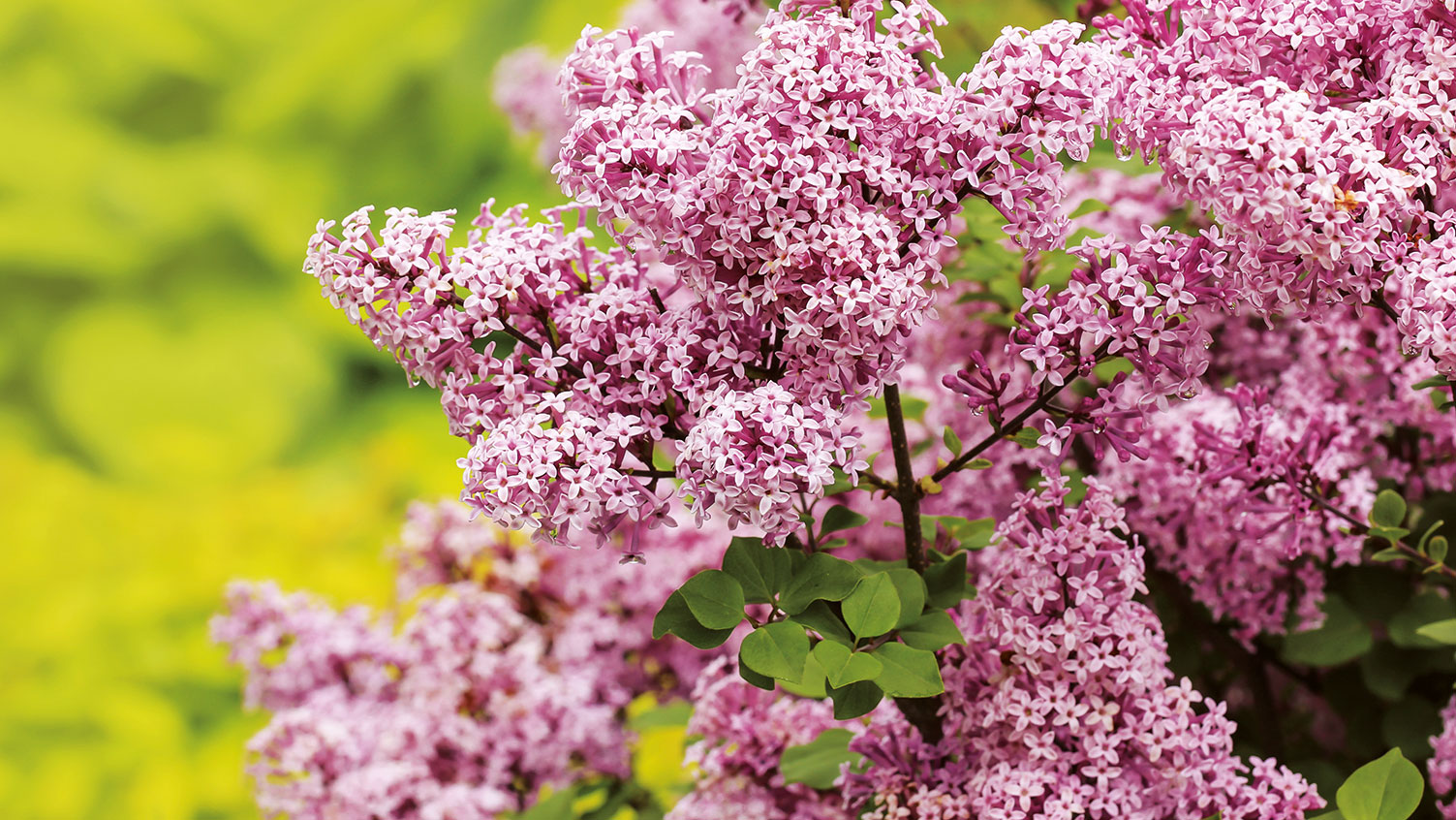How to grow lilac – for the best blooms
Bring color and fragrance to the yard in spring with the beautiful blooms of lilac


Discover how to grow lilac, Syringa, and you can enjoy clusters of fragrant blooms in mauve, pink, purple, or white in the springtime. Meet their simple needs and lilacs are easy to care for, rewarding gardeners with their color and scent when life returns to the backyard after winter’s finish.
Lilacs are often used in flower bed ideas but they’re also suitable as specimens in the lawn. The most common lilac is Syringa vulgaris, known as lilac bush or lilac tree, but there are other varieties to choose from, including the compact lilacs that are ideal for small gardens or even containers to brighten the patio in spring.
How to grow lilac in the garden
Lilacs are deciduous shrubs, losing their leaves in fall and growing new leaves along with their fragrant blooms in spring on the last year’s growth. They’ll grow 1 to 2 feet a year, and you’ll need to know both how to prune lilac and when to prune lilac to prevent them from getting too large with flowers at the ends of the branches where you can neither enjoy the blooms nor the scent properly.
They’re not just attractive to look at. ‘Incorporating lilacs into your garden will increase your ability to attract pollinators such as bees and butterflies,’ says Susan Brandt, co-founder of Blooming Secrets. ‘The nectar-rich flowers act as a magnet for pollinators.’
Lilacs can also enhance well-being. ‘The fragrance emitted by lilac blooms can create a soothing atmosphere and enhance the overall sensory experience in your garden,’ says Susan.

Where to grow lilacs
Lilacs are recommended for US hardiness zones 3 to 7. ‘They will grow in full sun or a partially shaded position,’ says Amateur Gardening expert Steve Bradley. Note that too little sun can mean fewer blooms and full shade isn’t suitable.
‘The best soil for lilacs is well-draining loamy soil that is neutral in pH,’ says Susan Brandt. ‘Loam soils are a mixture of sand, silt, and clay, providing a balanced texture that allows for proper water drainage while retaining enough moisture for the plants. They can tolerate clay soil, but it can stunt their growth.’
Lilacs won’t do well if they get what’s known as wet feet. ‘It is important to ensure good drainage in the planting area as excessive moisture can lead to root rot and other issues for lilacs,’ explains Susan. ‘If your soil has poor drainage, you can amend it by adding organic matter or creating raised beds.’
You can also learn how to grow lilac in pots as container shrubs, but be sure to 'use a high-quality potting soil mix,’ advises Susan, 'which will enhance nutrition and drainage.'

Steve has written (or co-written) over 40 practical gardening books, and was commissioned to update some of the world’s best-selling gardening books, The Expert series, originally written by Dr David Hessayon.
Over the years, Steve has also written for most of the popular UK gardening magazines, including Amateur Gardening. He is a member of The Garden Media Guild and has a vast knowledge of gardening and enjoys sharing it with listeners to BBC local radio in the UK. He is a resident gardening expert, answering listeners’ questions during live gardening phone-in shows.
How to plant lilacs
As with planting shrubs generally, get the right equipment before you begin. Plant lilacs in the fall before the first frost or in early spring. Dig a hole that’s both deep and wide enough for a container-grown lilac plant’s roots; the top of the root ball should be level with the soil. Backfill and gently firm the soil around the plant then water in the well. Add mulch to retain moisture in the soil and to cut down on weeds.
Bear in mind that it’s possible to propagate lilacs, by getting new plants from cuttings in spring and early summer.
Be sure to allow space for lilacs to grow when planting. Check the label for information on the spread, as well as height.
Water the plants regularly until they’re established.
How to care for lilacs
Lilacs aren’t demanding plants to care for but there are a few tasks that will help keep them healthy.
Add a layer of mulch annually in the spring. When considering how to fertilize lilacs, these plants can be fed after their first and second years, but it typically isn’t necessary to do so annually after that unless the soil is poor. Be sure to use a balanced (10-10-10) fertilizer in spring as growth begins. Once plants are mature, you should only need to water lilacs in a period of drought.
It’s worth deadheading a lilac only if it’s a variety that reblooms; otherwise, it merely tidies the plant. Pruning, on the other hand, is advisable to keep lilacs blooming well and to help them stay healthy.
Lilac varieties to grow
There are plenty of lilacs to choose from and growing different varieties with different blooming periods in the season can prolong the display.
‘When it comes to choosing specific lilac varieties for your garden, there are a few recommendations worth considering,’ says Susan Brandt. ‘One popular choice is the common lilac (Syringa vulgaris), which is known for its intense fragrance and classic purple blooms.
‘Another option is the Persian lilac (Syringa x persica), which features delicate pale pink or lavender flowers. For those looking for a more compact option, the dwarf Korean lilac (Syringa meyeri ‘Palibin’) is a great choice with its smaller size and vibrant lavender-pink flowers.’
FAQs
Does lilac come back every year?
Lilac does come back every year, but to ensure it blooms next spring, it is critical to prune at the right time. To be confident it’s not the following year’s buds that are removed, prune lilac immediately after it has finished flowering in the spring. Don’t prune in the summer or the fall. A lilac can also fail to bloom if it doesn’t receive adequate sun. Six hours of direct sun most days is recommended for the best show of flowers.
Lilac blooms are a welcome sight in the spring. ‘Lilacs are a beloved addition to any garden, offering both visual appeal and fragrant blooms,’ says Susan Brandt. ‘With their vibrant colors and unmistakable scent, these flowering shrubs can transform an ordinary garden into a captivating oasis.’ Don’t forget that they can make a splash inside a home, too, as part of a seasonal arrangement.
Sign up to the Homes & Gardens newsletter
Design expertise in your inbox – from inspiring decorating ideas and beautiful celebrity homes to practical gardening advice and shopping round-ups.

Sarah is a freelance journalist and editor. Previously executive editor of Ideal Home, she’s specialized in interiors, property and gardens for over 20 years, and covers interior design, house design, gardens, and cleaning and organizing a home for Homes & Gardens. She’s written for websites, including Houzz, Channel 4’s flagship website, 4Homes, and Future’s T3; national newspapers, including The Guardian; and magazines including Future’s Country Homes & Interiors, Homebuilding & Renovating, Period Living, and Style at Home, as well as House Beautiful, Good Homes, Grand Designs, Homes & Antiques, LandLove and The English Home among others. It’s no big surprise that she likes to put what she writes about into practice, and is a serial house renovator.
-
 5 vital ways a home battery backup can help with your most urgent needs in a power outage – from heating to flood prevention and calls
5 vital ways a home battery backup can help with your most urgent needs in a power outage – from heating to flood prevention and callsExperts say they're a worthy investment
By Clement Feng Published
-
 Is the viral salt hack the secret to a weed-free patio? A garden expert warns of irreparable, long-term damage – plus reveals the safest way to get results
Is the viral salt hack the secret to a weed-free patio? A garden expert warns of irreparable, long-term damage – plus reveals the safest way to get resultsYou might have seen gardeners on TikTok or Instagram using salt to kill weeds in pavers, but this hack should be avoided at all costs
By Thomas Rutter Published